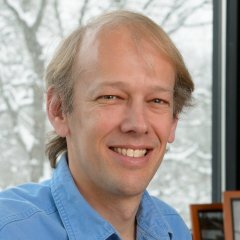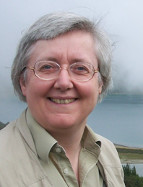Keynotes
We are proud to include three high-profile keynotes into our program:
- Pete Beckman — Sage Cyberinfrastructure for the Digital Continuum, from AI@Edge to Cloud
- Hiroki Sayama — Self-Organization of Society: Fragmentation, Disagreement, and How to Overcome Those
- Susan Stepney — Cyber-bio-physical systems engineering, or: can we grow a skyscraper?
Pete Beckman — Sage Cyberinfrastructure for the Digital Continuum, from AI@Edge to Cloud

Abstract: The number of network-connected devices (sensors, actuators, instruments, computers, and data stores) now substantially exceeds the number of humans on this planet. Billions of things that sense, think, and act are connected to a planet-spanning network of cloud and high-performance computing centers that contain more computers than the entire Internet did just a few years ago. Parallel computation and machine learning are providing the basis for this new computing continuum that analyses data in-situ, and uses HPC to model, predict, and learn. The NSF sponsored SAGE project is building a cyberinfrastructure to support artificial intelligence at the edge. From the edge to the cloud, SAGE will provide a new kind of programmable computing continuum that must reliable, self optimizing, and dynamic.
Biography: Pete Beckman is a recognized global expert in high-end computing systems. During the past 30 years, his research has been focused on software and architectures for large-scale parallel and distributed computing systems. For the DOE’s Exascale Computing Project, Beckman leads the Argo project focused on low-level resource management for the operating system and runtime. He is the founder and leader of Argonne’s Waggle project for artificial intelligence (AI) and edge computing. Pete also co-directs the Northwestern University / Argonne Institute for Science and Engineering and leads the Sage project funded by the National Science Foundation to build a nationwide infrastructure for AI at the edge to support ecological research for the National Ecological Observatory Network and urban research for the Array of Things. Beckman also coordinates the collaborative technical research activities in extreme-scale computing between the US Department of Energy and Japan’s ministry of education, science, and technology and helps lead the BDEC (Big Data and Extreme Computing) series of international workshops. He also coordinates 5G wireless research activities at Argonne.
Hiroki Sayama — Self-Organization of Society: Fragmentation, Disagreement, and How to Overcome Those

Abstract: Social fragmentation and widening disagreement among constituents have become a highly relevant and critical issue in our modern society. Such a trend may be understood as a consequence of (undesired) social self-organization facilitated by various sociopolitical and technological factors. In this talk, we will review our three recent modeling projects on this subject, addressing (1) formation of extreme ideas and social fragmentation caused by social conformity and homophily in adaptive social networks, (2) intensified disagreement among opinionated groups due to people’s enhanced ability of information gathering, and (3) how those problems might be overcome by social constituent diversity.
Biography: Hiroki Sayama is a Professor in the Department of Systems Science and Industrial Engineering, and the Director of the Center for Collective Dynamics of Complex Systems (CoCo), at Binghamton University, State University of New York, USA. He also holds a non-tenured Professorship in the School of Commerce at Waseda University, Japan. His research interests include complex dynamical networks, human and social dynamics, collective behaviors, artificial life/chemistry, interactive systems, and complex systems education, among others. He is an expert of mathematical/computational modeling and analysis of various complex systems. He has published more than 180 peer-reviewed journal articles and conference proceedings papers and has written or edited 14 books and conference proceedings about complex systems related topics. His open-access textbook on complex systems modeling and analysis (http://tinyurl.com/imacsbook) has been downloaded more than 57,000 times globally and has become one of the standard textbooks on this subject. He currently serves as an elected Council and Executive Committee member of the Complex Systems Society (CSS), the Chief Editor of Complexity (Wiley/Hindawi), an Associate Editor of Artificial Life (MIT Press), and as an editorial board member for several other journals.
Susan Stepney — Cyber-bio-physical systems engineering, or: can we grow a skyscraper?

Abstract: Today’s artefacts, from small devices to buildings and cities, are cyber-physical systems, with tightly interwoven material and computational parts. Currently, we build such systems, laboriously placing material components, laboriously programming computational ones, laboriously integrating the parts, laboriously maintaining the resulting structures, component by component. The results are often difficult to maintain, change, and reconfigure. Even “soft”ware is brittle and non-trivial to adapt and change.
The picture is different if we look to nature. Trees grow, adapting their form and function to the environmental conditions, and trees self-repair, using the same mechanisms as for growth. These properties allow trees to be gardened—planted, fed, pruned, trained—to meet human needs.
Adding in natural processes, or nature-inspired processes, result in cyber-bio-physical systems (which we dub zoetic systems, for short). Here I will discuss what such zoetic systems might look like, and outline a conceptual unconventional embodied computational architecture framework. This is based on a plant growth metaphor, for evolving and engineering zoetic ‘seeds’, then growing these seeds into mature zoetic systems, and gardening the physically growing systems in order to adapt them to specific needs. With such an approach, could we grow a skyscraper?
Biography: Susan Stepney is Professor of Computer Science and Director of the York Cross-disciplinary Centre for Systems Analysis at the University of York, UK. After starting as an astrophysicist, she moved to industrial R&D, working in formal methods for 18 years. In 2002 she returned to academia, and is now researching topics in unconventional computing and artificial life that focus on computation related to complex biological and physical processes.